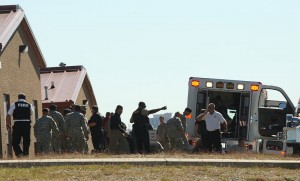The odds of experiencing an open shooter on BYU campus is comparable to the chance of being struck by lightning according to active shooter safety training video, “Shots Fired.” But if an open shooter were to come on campus, the effects would be catastrophic as shown in the tragic events at Columbine and Ft. Hood.

“Shots Fired” is a training video created by the Center for Personal Protection and Safety to prepare college campuses for active shooter situations. The 20-minute video is available for viewing on the University Police website. In light of the recent stabbing at a Pennsylvania high school and other incidents throughout the country, it is becoming increasingly important for students to be prepared and aware of their surroundings.
“If we had our way, we would ask you to watch it every six months,” University Police Lt. Lemmon said. “It’s not to instill fear; it’s to instill self-confidence.”
Lemmon said although the University Police has an extensive response plan in the event of a shooter or other attacker on BYU campus, it is important for students and faculty to know what to do.
“The campus community needs to be better prepared because their preparation increases the strength of our response,” Lemmon said. “We want you to be empowered. We want you to know what to do.”
He emphasized always having a ‘survival mindset,’ a concept taught by “Shots Fired.”
The video gives three steps to achieving this survival mindset: awareness, preparation and practice.
Awareness is essential to survival. Students and faculty are advised to take time to assess the situation and where they are in relation to the shooter and potential victims around the.
The next part of the survival mindset is preparation. Students and faculty must ask themselves “what if” questions and develop effective response strategies.
Last, “Shots Fired” advises students and faculty to rehearse or practice their plan.
The video urges students and faculty to take note of their surroundings in classrooms and buildings throughout campus. Be aware of exits and places to hide or run in case of an emergency.
“Shots Fired” advises students and faculty to remember the seven outs:
Figure out
Assess the situation. Know where you are in relation to the attacker.
Call out
Call 911. Be calm, clear and consistent.
Get out
If you have an exit route, take it.
Hide out
If you don’t have an exit route, find a place to hide that provides the best cover possible.
Keep out
Don’t go back to the location of the active shooter if you’ve been able to escape.
Spread out
If you are trapped, spread out. Don’t huddle in one corner like sheep. Don’t make it easier for the shooter to find his target.
Help out
If someone is injured, help him/her out.
Take out
If it comes down between you and the shooter, assume his or her intentions are lethal. Convince yourself you have what it takes to neutralize the shooter when your life is on the line.
According to a 2013 FBI study, it took law enforcement an average of three minutes to respond to the scene in the top five deadliest shootings since 2000.
The study noted the importance of citizens being prepared and knowing how to protect themselves in crucial minutes before officers arrive.
“Before the police get there, it’s against you and that bad guy. You can’t just sit there,” said officer Chris McMurtrey of the Eastern Washington University police department.
Do whatever is necessary to neutralize the shooter for the sake of your safety and the safety of others.
“If you’re in the same room with a shooter, then you have to decide, can I escape or will I fight for my life?” Lemmon said. He said most shooting incidents are “wolf and sheep” situations. When faced with an active shooter, most humans naturally want to huddle together in a corner.
However, he emphasized the importance of getting out.
“Get time and distance from that shooter,” he said. “That’s the optimal.”
The FBI study also reported that there has been a steady rise in the number of active shooter events from 2000 to 2012, especially after 2009. The study identified 110 active shooter events during this 12-year time period where the intent of the shooter was mass-murder. In addition, they reported an increase in the number of people that were shot and killed per shooting.
Lemmon said they are constantly doing training to be prepared if such a situation were to take place on BYU campus.
“To say we’re prepared, we’re never satisfied,” he said.
Violence on BYU campus can be prevented through measures taken by students and faculty members. Members of the BYU community can report suspicious activity to campus law enforcement, resident assistants, professors and counseling centers according to “Shots Fired.”
The closest BYU has come to a school shooting was years ago when a student became enraged with another student over an elevator incident and threatened him with a shotgun. The situation ended when the attacker turned the gun on himself instead.
Lemmon said BYU is one of the top 10 safest universities for its size in the U.S. He believes the university’s no-weapons policy makes it a safer environment for everyone.
To better prepare the BYU community for an active shooter on campus, the university has put together the Y Alert program to notify students and faculty via text messaging or email. Students can sign up for the program on police.byu.edu/content/emergency-preparedness-training.
“We hope that every member of our campus community participates in the Y Alert program by providing a text-enabled number. We will only use this number in the event of an emergency,” said Carri Jenkins of BYU communications.




